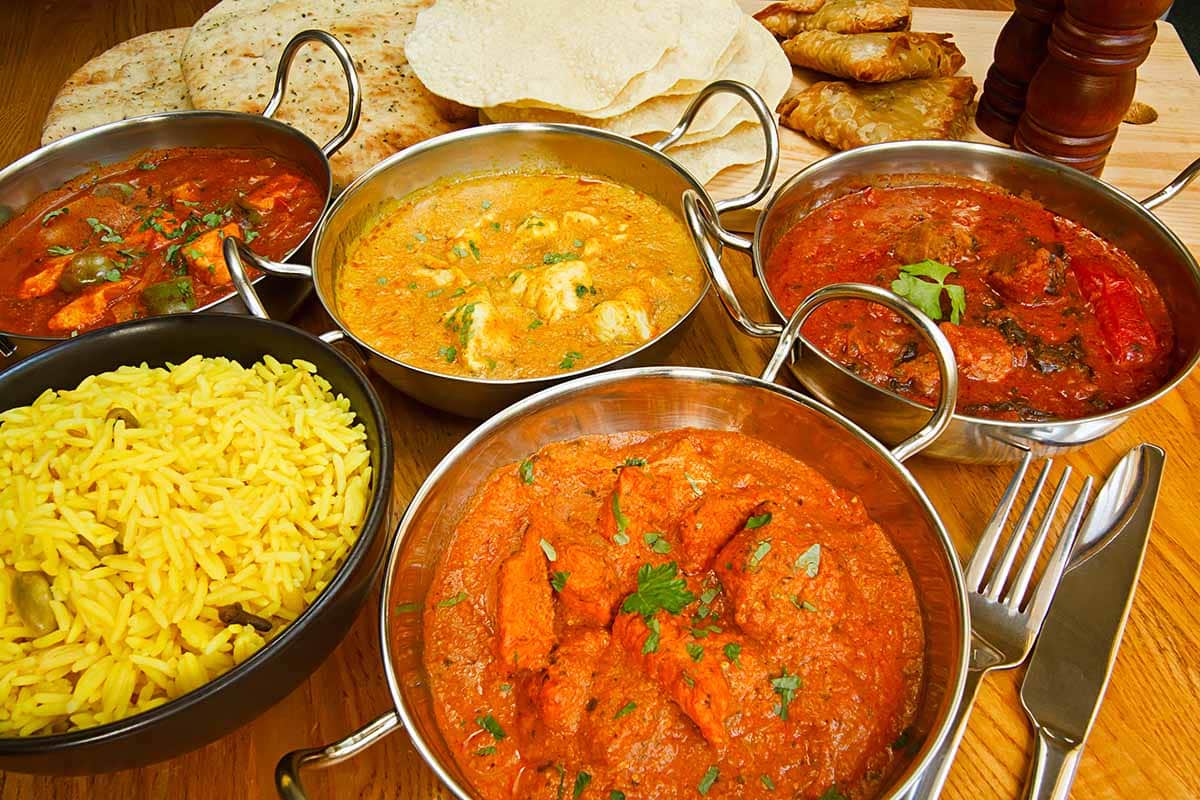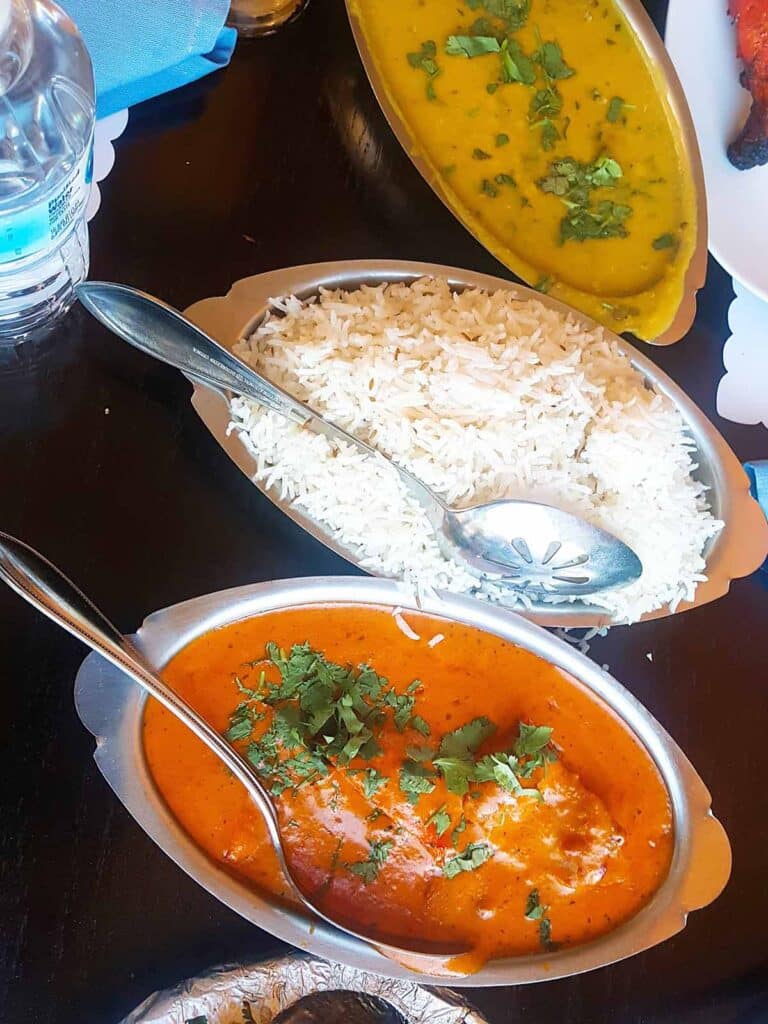In today’s food guide, we will compare green vs. red curry. We will discuss their ingredients, spice level, and flavor profile. We’ll help you discover the unique characteristics of each.
When it comes to South Asian cuisine, two curries stand out: green curry and red curry. These two curries have many similarities. They both have coconut milk and Thai herbs. But they also have distinct differences that set them apart.

Green curry is a popular Thai dish with a distinctive green color and spicy flavor. The curry uses a blend of aromatic ingredients. It usually has fresh green chilies, coriander, kaffir lime, shrimp paste, and Thai basil.
Also, green curry can have cumin, shallots, lemongrass, galangal, garlic, and fish sauce. That said, it has a complex but flavorful taste.
People also use the leaves and peels of kaffir lime to help make the green color more vibrant.
The addition of coconut milk helps to tone down the green curry’s spice level.
Most people say that green curries are generally the spiciest of all Thai curries.
Compared to curries from other countries, green curry is the most distinct. It is different because it uses fresh ingredients, giving it a unique flavor profile.
Green curry is worth trying if you enjoy spicy and flavorful food.
Red curry is another type with a red color and bold flavor profile. The distinctive red hue of this curry comes from the use of red chili peppers in the paste.
People soak and pound the red peppers with the other ingredients to get the heat and the color from them.
The traditional version of the red curry can have up to 20 red chilies, making it fairly spicy. But most modern versions are milder.
Chefs nowadays use chili powder and paprika instead of more chilis when making red curry. Sometimes, people even use tomato sauce to enhance the color and flavor of the red curry.
Like in green curry, the coconut milk in the sauce helps tone down the red curry’s spiciness.
Red curry also has garlic, shallots, galangal, kaffir lime peel, shrimp paste, and lemongrass. You’ll notice that these are also the same ingredients you’ll find in green curries.
With its usually milder spice level, red curry is versatile, delicious, and flavorful. That said, it is no surprise that many Thai food enthusiasts love it.
There are a few notable differences in taste when comparing red curry vs. green curry.
First, green curry is typically hotter than red curry.
After all, it has fresh green chillies, which can be hotter than red chilis. And since red curry sometimes has chili powder and tomato sauce, you can make it using fewer chilis.
However, you can always customize the spice levels of these curries. You can alter the curry recipe depending on your heat level tolerance.
Both curries share similar herbs and spices in their paste. But green curry is unique in its flavor profile, thanks to fresh herbs like coriander and basil. Adding the leaf and peel of kaffir lime also gives green curry a brighter and sharper taste.
On the other hand, red curry has a bolder and more savory taste. Its ginger and garlic notes are more evident than the flavors of its other ingredients.
That said, red curry is not as complex as green curry. But this characteristic makes it more versatile and popular in Thai dishes.
In short, people who like spicier dishes may prefer green curry to red ones. Conversely, those who prefer a bolder and savory taste may find red curry the better choice.

Green curry paste is best for dishes that need a fresh and vibrant taste. Its flavor profile makes it perfect for seafood, chicken, and beef dishes. Tofu and vegetables also work well with green curry paste.
On the other hand, red curry paste is more versatile, so you use it in a wider range of dishes. Its depth of flavor makes it a great base for meat and vegetable stews and soups.
You may even use it in marinades. Red curry also works well in Thai-style pasta or stir-fried noodles.
People typically serve both curries with rice. The neutral taste of rice helps you to enjoy the flavor of either green or red curry best. Plus, rice absorbs the flavor of curry well, so they’re a perfect pair.
Red and green curries indeed differ in flavor profile and usage.
You can use green and red curry pastes interchangeably in most dishes despite these factors.
No, green curry and red curry do not taste the same.
While they are both Thai curries, they have distinct flavors and ingredients that set them apart.
The overall taste of green curry is often described as aromatic, zesty, and herbaceous.
Red curry has a richer, slightly sweeter flavor profile, often due to the inclusion of ingredients like coconut milk and palm sugar.
Pro Tip:
The taste of each curry depends on the specific recipe used and individual preferences. Green curry tends to be spicier and more herbaceous, while red curry is milder and has a sweeter undertone.
It depends. Most people say that green curry is the spiciest curry because of the types of chili it contains. But the truth is, the spice level depends on how much chili you use for your curry recipe.
You can make red chili spicier than a green curry if you use fewer chilis and vice-versa. Note that if you add yellow curry to the list, there is no question that either red or green curries are spicier.
There are several ways to mellow the spiciness of curries.
Yes, green curry can be spicy. As mentioned, the spiciness depends on how much chilis you use in your recipe. So, you can adjust the spiciness of green curry according to your preference.
Plus, the spice level is subjective. What one person finds spicy, another may not. That said, it’s always best to do a taste test before adding it to your dish.
In the traditional recipe, red curry mostly gets its color from red chili peppers. But depending on the recipe, the red hue of this curry can also come from either chili powder, paprika, and tomato sauce. All these ingredients give the red curry its characteristic color.
Yellow curry is milder in terms of spice compared to green or red curry. It is influenced by Indian flavors and often includes ingredients like turmeric, cumin, and coriander, which give it a distinct yellow color and a subtle, aromatic taste. While the yellow curry is generally considered mild, it’s important to note that the level of spiciness can still vary depending on the specific recipe and the amount of chili used.
Green and red curries are popular Thai curries. Both use coconut milk and have similar ingredients, like garlic, shallots, and lemongrass. However, green curry has a more complex and fragrant flavor profile.
Red curry has a bolder and savory taste with evident notes of ginger and garlic. Most claim that green curry is spicier than Thai red curry. But the spiciness of these curries depends on the number of chilis they have. Ultimately, the choice between green vs. red curry depends on personal preference.





